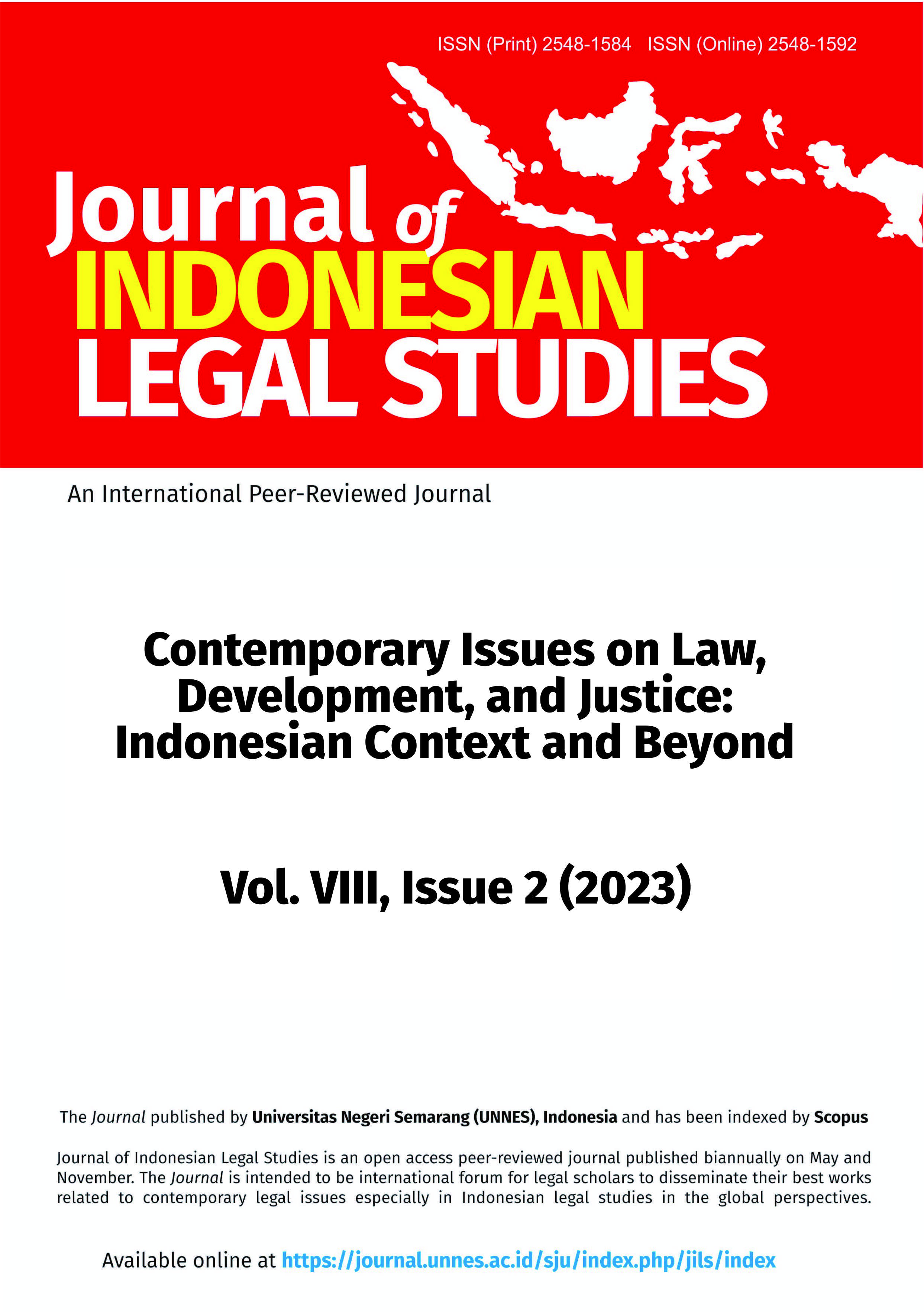Conceptualizing Policy on Underwater Cultural Heritage: Towards Legal Protection and Ecotourism Promotion in Karimun Jawa, Indonesia
Main Article Content
Abstract
Karimun Jawa Island is a promising maritime asset, enriched by abundant water resources in Central Java. However, the allure of this location poses a potential threat to the sustainable ecosystems of marine biota unless prompt government action is taken to safeguard its underwater cultural heritage. This research proposes a comprehensive policy design for legal protection and ecotourism development in Karimun Jawa, balancing economic considerations and environmental preservation. Employing a socio-legal methodology encompassing interviews, observation, and focus group discussions, the study identifies substantial challenges in managing underwater cultural heritage in Karimun Jawa. These challenges encompass over-exploitation, shipwreck theft, damage from trawlers, natural disasters, and plastic pollution. The research underscores the imperative for the government to formulate measures ensuring legal protection on international, national, and regional fronts. At the global level, immediate ratification of the Convention on the Protection of Underwater Cultural Heritage 2001 is recommended. Moreover, effective collaboration among stakeholders—central and regional governments, local communities, and maritime enterprises—is deemed crucial for sustainable, culturally informed policy formulation fostering responsible management, utilization, and protection of this unique marine heritage.
Article Details

This work is licensed under a Creative Commons Attribution-ShareAlike 4.0 International License.
All writings published in this journal are personal views of the authors and do not represent the views of this journal and the author's affiliated institutions. Author(s) retain copyrights under the licence of Creative Commons Attribution-ShareAlike 4.0 International (CC BY-SA 4.0).
References
Apriando, Tommy. “Tongkang Batubara Parkir di Karimunjawa Rusak Terumbu Karang,” MONGABAY, September 23, 2018, https://www.mongabay.co.id/2018/09/23/tongkang-batubara-parkir-di-karimunjawa-rusak-terumbu-karang/.
Aznar, Mariano J. “In Situ Preservation of Underwater Cultural Heritage as an International Legal Principle,” Journal of Maritime Archaeology 13, No. 1 (2018): 67–81. https://doi.org/10.1007/s11457-018-9192-4.
Argyropoulos, Vasilike, and Anastasia Stratigea, “Sustainable Management of Underwater Cultural Heritage: The Route from Discovery to Engagement Open Issues in the Mediterranean”, Heritage 2 (2019): 1588.
Arianto, Wisnu. "Desain Kapal Wisata Katamaran untuk Kepulauan Karimunjawa", Thesis (Surabaya: Institut Teknologi Sepuluh Nopember, 2016).
Ardiwidjaja, Roby. Pengembangan Destinasi Pariwisata Berbasis Lingkungan (Sleman: Kepel Press, 2013).
Bomin, Nie. “On the International Legal Protection of Underwater Cultural Heritage,” China Oceans Law Review 2015, No. 2 (2015): 300–323.
Flecker, Michael. “The Thirteenth Century Java Sea Wreck: A Chinese Cargo in an Indonesian Ship.” The Mariner’s Mirror 89 (2003): 388–404.
Flecker, Michael. Legislation on Underwater Cultural Heritage in Southeast Asia: Evolution and Outcomes, Trends in Southeast Asia (Singapore: ISEAS Publishing, 2017).
Kusumastanto, Tridoyo. “Arah Strategi Pembangunan Indonesia Sebagai Negara Maritim,” Online, 2013. Retrieved from https://www.researchgate.net/profile/Tridoyo-Kusumastanto-2/publication/266080942_Arah_Strategi_Pembangunan_Indonesia_sebagai_Negara_Maritim/links/5424e03d0cf238c6ea73bbd0/Arah-Strategi-Pembangunan-Indonesia-sebagai-Negara-Maritim.
Muhammad, Simela Victor. “Indonesia Menuju Poros Maritim Dunia,” Info Singkat Hubungan Internasional, November 2014.
Pearson, Natali. “At What Cost: The Impact of Indonesia’s Omnibus Law on Underwater Cultural Heritage,” New Mandala March 12, 2021, https://www.newmandala.org/at-what-cost-the-impact-of-indonesias-omnibus-law-on-underwater-cultural-heritage/.
Pearson, Natali. “Protecting and Preserving Underwater Cultural Heritage in Southeast Asia,” in The Palgrave Handbook on Art Crime (London: Palgrave Macmillan, 2019), 685–730.
Pearson, Natali. “Resisting Internationalism?: The Evolution of Indonesia’s Shipwreck Legislation,” Bijdragen Tot de Taal-, Land- En Volkenkunde 178, no. 4 (2022): 379–409.
Putranto, St. Prabawa Dwi, and Agus Aris Munandar, “Underwater Archaeological Museum: Utilization of Karimunjawa Sites,” in Proceeding ISETH (International Conference on Science, Technology, and Humanity) (The 2nd International Conference on Science, Technology and Humanity, Surakarta: Universitas Muhammadiyah Surakarta, 2016), 28–37, https://proceedings.ums.ac.id/index.php/iseth/article/view/2352/2307.
Pretylia, Vinca. “Tinjauan Hukum Pelelangan Benda Berharga Muatan Kapal Tenggelam (BMKT)”, University of Bengkulu Law Journal 2, No. 2 (2017): 165-184. https://doi.org/10.33369/ubelaj.2.2.165-184
Ramelan, Wiwin Djuwita “Permasalahan Pengelolaan Cagar Budaya Dan Kajian Manajemen Sumber Daya Arkeologi,” in Arkeologi Untuk Publik (Jakarta: Ikatan Ahli Arkeolog Indonesia (IAAI), 2012), 186–199.
Rahardjo, Supratikno. “International Convention Vs National Interest: Contestation among Indonesian Government Institutions on Underwater Cultural Heritage Conservation,” Indonesian Journal of International Law 16, No. 3 (2019): 347–60, https://doi.org/10.17304/ijil.vol16.3.763.
Rahardjo, Supratikno. “Prospek dan Tantangan Arkeologi Maritim di Indonesia.” Amoghapasa 13, No. 1 (2019): 6–10.
Ridwan, Nia Naelul Hasanah, “The Importance of Empowering Local Community in Preserving Underwater Cultural Heritage in Indonesia: Case Study in Tulamben, Bali and in Taka Kappala, Selayar-South Sulawesi.” Asia Pacific Regional Conference on Underwater Cultural Heritage, Manila, The Philippines, 2011.
Ridlo, Muhammad Mu’adz Hafidz, and Muhammad Faizal Alfian, “Posisi Indonesia dalam Rezim UNESCO Perlindungan Cagar Budaya Bawah Air: Pencurian Bangkai Kapal Milik Asing si Laut Indonesia,” Journal of International Relations 7, No. 2 (2021): 66–76, https://doi.org/10.14710/jirud.v7i2.30454.
Republic of Indonesia. (1989). Presidential Decree No. 43 of 1989 concerning the National Committee for the Salvage and Utilization of Valuables Originating from the Cargo of Sunken Ships [Keputusan Presiden No. 43 Tahun 1989 tentang Panitia Nasional Pengangkatan dan Pemanfaatan Benda Berharga Asal Muatan Kapal yang Tenggelam].
Republic of Indonesia. (2016). Minister of Maritime Affairs and Fisheries Regulation No. 4/PERMEN-KP/2016 concerning Temporary Suspension (Moratorium) of Survey Licensing and Removal of Valuable Objects from the Cargo of Sunken Ships [Peraturan Menteri Kelautan dan Perikanan No. 4/PERMEN-KP/2016 tentang Penghentian Sementara (Moratorium) Perizinan Survei dan Pengangkatan Benda Berharga Asal Muatan Kapal yang Tenggelam].
Republic of Indonesia. Law No. 23 of 2014 on Local Government [Undang-Undang Nomor 23 Tahun 2014 tentang Pemerintahan Daerah]. (Jakarta: Sekretariat Negara, 2014).
Supratikno Lillie, Malcolm, and Robert Smith. International Literature Review: In-Situ Preservation of Organic Archaeological Remains. (Hull: Wetland Archaeology & Environments Research Centre, 2009).
Sulistyarto, Priyatno Hadi. Melacak Jejak Budaya Bahari di Kepulauan Karimun Jawa (Tahap II). (Yogyakarta: Balai Arkeologi Yogyakarta, 2011).
Sulistyarto, Priyatno Hadi. Melacak Jejak Budaya Bahari di Kepulauan Karimun Jawa (Tahap I). (Yogyakarta: Balai Arkeologi Yogyakarta, 2009).
UNESCO and Permanent Delegation of the Republic of Indonesia to UNESCO, Rekam Jejak 70 Tahun Indonesia UNESC) 1950-2020 (Paris: Kantor Delegasi Tetap Republik Indonesia untuk UNESCO, 2020).
United Nations Environment Programme (UNEP), Green Economy and Trade Trends, Challenges and Opportunities (Nairobi: United Nations Environment Programme, 2013).
Wijayanto, Punto. “Community Involvement in Heritage Conservation: the Case of Kotagede, Indonesia”, In Kapila D. Silva (ed.), The Routledge Handbook on Historic Urban Landscapes in the Asia-Pacific (Oxon: Routledge, 2020), pp. 445–461.
